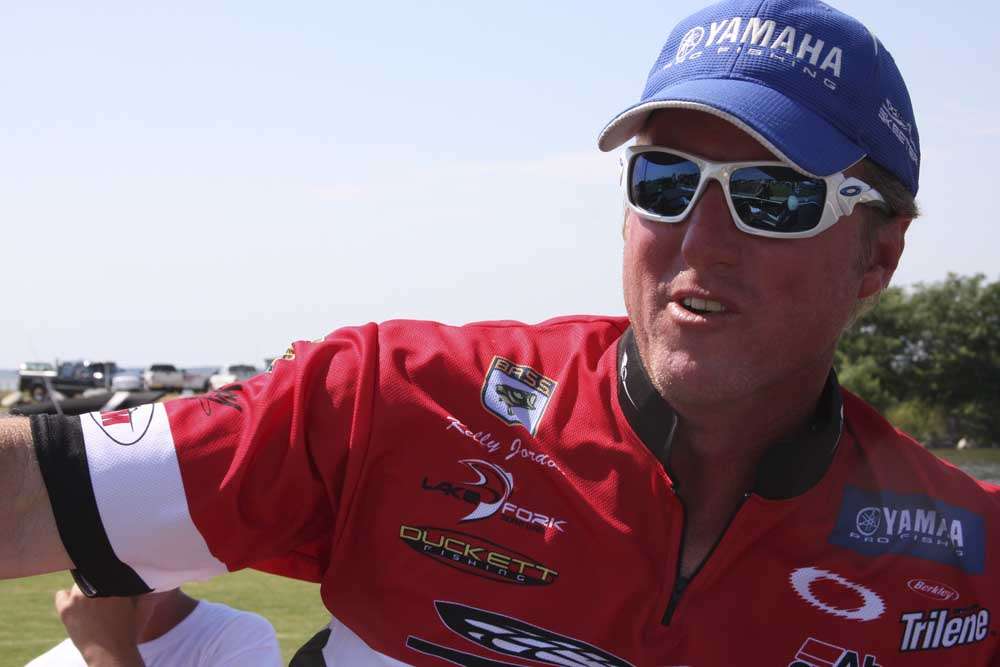
"They" say there's nothing new under the sun, and "they" may be right. After watching Jeremy Starks and Britt Myers finish 1-2 at the Douglas Lake Elite Series tournament last week, it looked like we were watching a new technique being unveiled — long lining was having its coming out party.
Except that it wasn't.
It turns out that anglers around the country have been using the method for years — decades even — to catch bass at depths that crankbaits couldn't reach on a conventional cast and retrieve.
If you missed it, Starks, Myers and several other Elite anglers were getting their deep-diving cranks to 30, 35 and perhaps as deep as 45 feet by making a long cast, then keeping their reels in free-spool while the bait bobbed in the waves and they moved away, so that the motor is not moving the lure. After they had backed away 200 or even 300 yards, they'd start the retrieve. A single cast and retrieve was taking as long as five or even 10 minutes, limiting Starks to just 40 or 50 casts a day. It hardly mattered, though, since he was catching a bass on nearly every cast.
There are several important things to consider here.
First, it's against the rules of most tournament organizations to use either your outboard or electric motor to move your bait. That's trolling, and it's a big no-no.
Second, there are lots of factors that limit the running depth of a crankbait — line size and composition, bait size and design, retrieve speed and trajectory just to name a few — but the most limiting component has always been retrieve distance. A long cast by anyone's standards would be 70 yards, and no conventional crankbait is going to dive deeper than 25 feet or so on a cast of that length. But if you can stretch the length of the retrieve, you can get the bait deeper.
Enter long lining.
A technique by any other name
"I first tried it in 1989 or 1990," says Elite Series pro and Texan Kelly Jordon. "I developed it on my own, but I'm certain there were other guys doing it before me. I was just looking for a way to get a crankbait deeper than you could on a regular cast, and back then a lot of Texas bass tournaments allowed you to troll with your electric motor."
The nine-time Classic qualifier didn't call the technique "long lining," however.
"We called it 'strolling'," he said, "and it wouldn't be legal in a B.A.S.S. tournament because we used the trolling motor to help move the bait. That's when we came up with 'stroll casting,' which is the same as long lining."
Brushes with the spotlight
As Jordon tells it, long lining or stroll casting has come close to being exposed by the outdoors media on several occasions. Jordon and three teammates used it to win the Toyota Texas Bass Classic a few years ago, and it was a factor in the Elite tournament on Wheeler Lake in 2011.
It wasn't until Starks and Myers, however, that long lining was used so prominently in a major win. "A lot of the guys who use it have been trying to keep it quiet for a long time," Jordon says.
Jordon, who finished 17th at Douglas Lake, admits to having missed a long lining opportunity there. "I stopped looking for them at about 30 feet deep. It wasn't until the end of practice that I realized I had missed it. At about 1:30 on the last practice day I tried it with a Lucky Craft D20 and was hitting bottom in about 39 feet of water when a 7 pounder hit. It was too late for me to put anything together, though."
Gearing up
For his long lining or stroll casting, Jordon likes a 7-foot, 11-inch medium-heavy Micro Magic cranking rod from Duckett Fishing. He'd go with an even longer model, but many tournament circuits (including the Elite Series) prohibit rods over 8 feet. He likes the Abu Garcia Revo STX or Premier in a 6.4:1 gear ratio for his cranking reel, and has found these models suit his needs well, though he says further customization might give some anglers a longer cast.
"I've seen some custom reels with ceramic bearings that could cast over 100 yards," Jordon says, "but if you make one little mistake with them, you're looking at an epic backlash. With my gear, I can cast 75 yards or so, and long casts are critical because they save time."
Jordon also emphasizes the need for extremely castable baits — especially crankbaits that have a weight-transfer system that allow for longer casts. His favorite deep-diving crankbait is the Lucky Craft Flat CB D20. It's the bait he was using at Douglas to catch the big fish in practice. It reached 39 feet on that presentation, but Jordon knows he can get it even deeper if he needs to.
As for line, conventional wisdom says lighter lines will help crankbaits get deeper, and that was certainly true in the days of monofilament. There's some debate, however, now that most anglers are using fluorocarbon for their cranking. Fluorocarbon sinks, though not likely fast enough to make a difference with this method.
Jordon likes 10- or 12-pound test Berkley Trilene 100% Fluorocarbon for his cranking. He says lines lighter than 10 will cost you too many baits, but heavier than 12 will cost you too many bites.
How deep can you go?
"I know my Lucky Craft D20 was getting down to 39 feet at Douglas," Jordon says, "but I think you can go deeper. I'd never tried to go that deep before."
Of course, the key to successful long lining or stroll casting is not just how deep you can make the bait go, but putting it near catchable bass. For that, you need to be good with your electronics. You have to find the bass, get lined up on them and be able to put your bait on target time after time. Casts can take five to 10 minutes each, so missing the mark — even by a few feet — results in a considerable waste of time and effort.
"When I started stroll casting," Jordon says, "I'd mark the area I wanted to hit with a buoy. Now I just use my electronics — especially my GPS — but a buoy could be a big help for anglers who are just learning the technique or who aren't as familiar with their electronics. Just be sure to put the buoy off to one side so you don't snag it."
Ultimately, the depth bass anglers can reach with a crankbait is determined by physics. Nevertheless, with long lining, high capacity spools, fluorocarbon lines and proper rod trajectory, "deep-diving" is taking on a whole new meaning.





